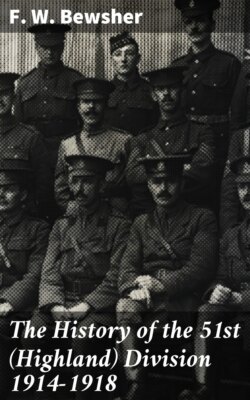Читать книгу The History of the 51st (Highland) Division 1914-1918 - F. W. Bewsher - Страница 14
CHAPTER V.
THE BATTLE OF THE SOMME—HIGH WOOD.
ОглавлениеThe Division entered the area of the Somme battle under bad auspices. It undoubtedly required a rest before it could be expected to reproduce its true form. On the 21st of July it received orders to take over the line on the same evening. On the 22nd it received orders to carry out an attack. Moreover, this attack, for which the Division was given less than twenty-four hours to prepare, was to be delivered from the point of a salient. There was, in fact, a general impression throughout the Division when they left the Somme area that their efforts had not been attended by a reasonable chance of success.
As far as the Highland Division is concerned, the tactical feature with which this phase of the Somme operations is primarily associated is High Wood. This wood, the highest point in Picardy, is perched on the summit of a large upland flanking the road, which, passing between the two Bazentins, leads from Contalmaison to Longueval.
Between the two Bazentins is the road junction where the road through the Mametz valley strikes the Contalmaison-Longueval road.
During previous operations, in which the 7th Dragoon Guards and the Deccan Horse had participated, the whole of High Wood had been captured. The enemy had, however, regained a footing in it. When the Division arrived in this area the German line ran through Guillemont, through Delville Wood north-east of Longueval, through High Wood, but on the reverse slope of this aforementioned upland, north of Bazentin-le-Petit, and between Contalmaison and Pozières.
The enemy did not, however, hold sufficient of High Wood to secure observation of the country south-west of it, with which the Division was primarily concerned.
Of this section of the front the portion taken over by the Division at one time or another during its tour at duty in the line ran from a point about half-way between Longueval and High Wood to Bazentin-le-Petit exclusive.
The Divisional area was traversed throughout its length by the road which ran from Becourt-Becordel-Fricourt, south of Mametz Wood-Bazentin, and on to Longueval.
The Mametz Valley, through which this road ran, was familiarly called the Happy Valley. The valley, with the possible exception of the Chemical Works at Roeux, has probably stamped itself more on men’s minds than any other topographical feature with which the Division came in contact. In Happy Valley was situated the headquarters of the brigade in the line, and of the supporting brigade itself. In addition, the advanced dressing station and many batteries were also located in it.
Running as it did towards the apex of a salient the enemy could concentrate a tremendous weight of artillery against it. Thus, when he was bombarding it with his maximum intensity, shells used to arrive from the direction of Leuze Wood in the right rear, and from Gueudecourt and Courcelette frontally, and from behind Pozières on the left.
This valley was the only line of communication through which every relief, every round of ammunition, and every ration had to pass on their way to the line, not only for the Highland Division but for several neighbouring Divisions.
Portions of the valley were under observation from balloons, while throughout its whole length the clouds of dust raised by the continual stream of wheeled traffic disclosed to the enemy any considerable movement that was taking place in it.
The enemy shelled Happy Valley mercilessly day and night, an intense barrage of high explosive, air bursts and gas shells being placed completely across it at irregular intervals, and moved backwards and forwards, up and down it.
